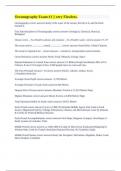Oceanography Exam #1 || very Flawless.
Oceanography correct answers Study of the water of the oceans, the life in it, and the Earth
beneath it.
Four Sub-disciplines of Oceanography correct answers Geological, Chemical, Physical,
Biological
Ocean covers __% of Earth's surface, and contains __% of Earth's water. correct answers 71, 97
The ocean and its ____ ____ control ____ ____. correct answers Stored Heat, Global Climates
The ocean is important for... correct answers ...commerce, transportation and recreation.
Ocean Resources correct answers Water, Food, Minerals, Energy, Space
Human Habitation in Coastal Zone correct answers 3.2 Billion People Worldwide, 80% of US
Citizens, 8 out of 10 Largest Cities, 3,600 people move to coast each day.
The Four Principal Oceans (+1) correct answers Pacific, Atlantic, Indian, Arctic,
(+Southern/Antarctic)
Average Ocean Depth correct answers ~3,796 Meters
Average Elevation of Land correct answers 840 Meters
Deepest Part of Ocean correct answers Mariana's Trench at 11,022 Meters Deep.
Highest Mountain correct answers Mount Everest at 8,850 Meters High.
Total Maximum Relief on Earth correct answers 19,872 Meters
Early Period correct answers Up to ca 1400 CE (Includes Middle Ages); First Used as Food
Source, Migration/Trade by Vikings, Phonecians, Chinese, and Micronesians; Later by Romans
& Greeks for Political/Military Reasons
Early Period Accomplishments correct answers First Maps, Magnetic Compass, Size/Shape of
Earth, System of Latitudes, Tides
Middle Period correct answers ca 1400-1800 CE (Age of Discovery); Exploration/Mapping by
Western Man, Used for Trade/Colonialism/National Security, No Academic Study.
Middle Period Names correct answers Henry the Navigator, DeGamma, Magellan, Drake, Cook,
Henry Hudson, Columbus
, Middle Period Accomplishments correct answers Accurate Maps of Worlds & Oceans, Sextant,
Chronometer, System of Longitude, Mercator Projection Maps, Notes on Local Biota.
Modern Period correct answers ca 1800 CE to Present; Primary Motivation Still Economic and
Political, Includes First Systematic Scientific Studies
Modern Period Accomplishments correct answers 1777: Ben Franklin's Map of Gulf Stream;
1807: US Coast and Geodetic Study (NOAA); 1830: Voyage of the Beagle, Darwin; 1872:
Voyage of the HMS Challenger (First Purely Scientific Oceanographic Study)
Pacific Ocean correct answers Largest (width half circumference of Earth), nearly circular,
deepest (greatest average depth because of many deep trenches), coldest and least salty, and
numerous islands and volcano.
Atlantic Ocean correct answers Second largest, "S" shaped, shallower (large central ridge,
average depth 3310 m), saltier than average; Mediterranean water.
Indian Ocean correct answers South of Tropic of Cancer, roughly symmetrical (more or less
circular), smallest of the three main oceans.
Arctic Ocean correct answers Almost enclosed by land, nearly all above the Arctic circle,
dominated by ice, largest connection with Atlantic/major influence on Atlantic.
Southern/Antarctic Ocean correct answers Defined by a set of physico‐chemical oceanographic
parameters that distinguish the Antarctic water mass from the other water masses.
Universe Origin correct answers 13-15 Ga; Big Bang Theory
Solar System Origin correct answers ~5 Ga; Condensation of Solar Nebulae
Earth Origin correct answers ~4.5 Ga; several hypothesis; most involve condensation
and collapse of part of the solar nebulae, era of impacts; then fractionation/ differentiation,
degassing, cooling.
Atmosphere Origin correct answers Ongoing; original atmosphere lost; atmosphere continually
evolves as a result of degassing, abiotic and biotic processes; earliest known atmosphere much
different from current.
Oceans Origin correct answers About 4.0 Ga (Billion Years Ago)
Oldest Fossils correct answers 3.5 Ga (Billion Years Ago)
Oldest Rocks on Earth correct answers 3.99 Ga (Billion Years Ago)
Oldest Ocean Floor correct answers 200 Ma (Million Years Ago)




